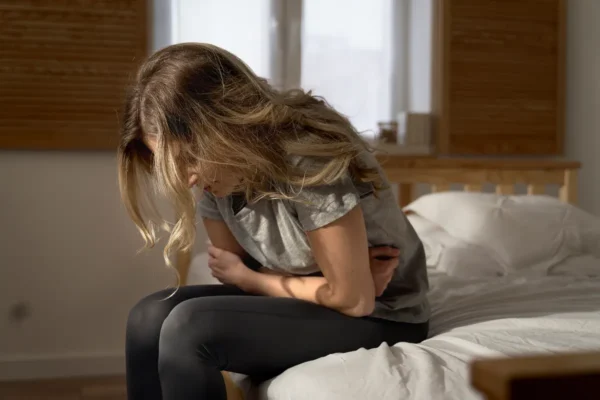Can Perimenopause Cause Pelvic Pain?
By Ashley Nowe
Published:

In short, yes. Pelvic pain in perimenopause is common, thanks to shifting hormones. While uncomfortable, there are treatment options that can provide relief. Let’s get into it.
Is Pelvic Pain Common in Perimenopause?
Though hot flashes seem to get the bulk of attention, pelvic pain is another common symptom of perimenopause. Changes in urinary urgency, frequency, and pain in the pelvic floor all fall under this general pelvic pain umbrella. According to the Mayo Clinic, up to half of women experience genitourinary symptoms in the leadup to menopause.
Other pelvic symptoms that can pop up in perimenopause include vaginal dryness, pain with sex, incontinence, or a feeling of heaviness possibly caused by pelvic organ prolapse. These symptoms occur throughout the month, not just during your period, even if it is irregular. And while the level of pain varies from symptom to symptom and person to person, they are uncomfortable across the board.
What causes Pelvic Pain in Perimenopause?
If you’re experiencing pelvic pain, estrogen is the likely culprit. (But if you are on your period, it might be regular menstrual cramps.)
Estrogen plays a key role in regulating your menstrual cycle. As estrogen levels decline during perimenopause, so does its presence in the genitourinary tissue – the tissues in your pelvic region. Less estrogen in the pelvic floor means less blood flowing around the tissues. This causes pelvic tissue to become thinner and more easily irritated, leading to pain and discomfort.
Other factors, like fibroids, scar tissue, and recurring UTIs, can also cause pelvic pain. Depression, anxiety, or abuse may also impact your pelvic floor. If any of these apply, it is important to see a medical professional for further assistance.
How Estrogen Affects the Pelvic Floor
Let’s dig deeper. Estrogen, or rather, the lack of it, is a major cause of pelvic pain in menopause and perimenopause.
Estrogen is vital to maintaining the health of your pelvic floor. It ensures elasticity and strength in the pelvic tissues. It also helps regulate blood flow to your pelvic organs.
In perimenopause, estrogen levels naturally decline. Studies show that there’s a link between low estrogen and pelvic floor disorders, like urinary incontinence or sexual dysfunction. Read more about the estrogen changes during perimenopause.

How to Ease Pelvic Pain During Perimenopause
Of course, treatment depends on the underlying cause of the pelvic pain, but a combination of lifestyle changes, vaginal estrogen cream, and/or pelvic floor physical therapy can provide the relief you deserve.
Anne Collins Duch, PFPT, offers some great advice on managing pelvic floor health and what to do if you’re experiencing pelvic pain (with no period).
Lifestyle Treatments
A nutritious diet, regular exercise, rest, and reducing stress will keep pelvic symptoms at bay.
- Eat plenty of fruits, vegetables, and whole foods, and avoid simple sugars and processed foods.
- Staying active helps improve your quality of life overall. Walk, lift heavy, and stretch out. Check out the range of exercise programs available on Menovation.
- Your pelvic floor muscles are like the rest of the muscles in your body – use them or lose them. Regular sexual activity (with or without a partner) can help maintain healthy tissue.
Estrogen Cream and HRT
Topical estrogen cream can also be a godsend for people in perimenopause with pelvic pain. In fact, it might be one of the most beneficial things you can do if you’re experiencing pelvic pain.
According to Duches, topical estrogen cream is safe for all. It stays localized to the vulvar tissues that you put it on – the tissues on the outside of the vagina and then up into the vagina.
You do need a prescription from your provider, so ask about the benefits and potential side effects, to decide if topical estrogen cream is a good option for you.
HRT, or Hormone Replacement Therapy, is another option for some people looking to increase estrogen in their bodies. HRT may help relieve a number of perimenopause symptoms, including pelvic pain.
As with any medication, it is important to do your research and speak with a medical professional about your history and needs to see if you are a candidate for this treatment.
Pelvic Floor Physical Therapy
If it’s available to you, pelvic floor physical therapy (PFPT) is a great option, and it’s NOT just for those who are recently postpartum.
PFPT is so much more than just “do a million kegels.” As women age and estrogen declines, pelvic floor muscles can weaken or they can become too tight and inflexible. A professional will help determine your situation and appropriate exercises to improve pelvic floor function.
Remember, it will take time, and you may need to try a few different modalities before you find what works best to relieve your pelvic pain. But there is relief.
When the Pain is Too Much to Handle
If you’re experiencing chronic pelvic pain that is severe and impacting your daily life, please seek help from a medical professional. An OB-Gyn will likely perform a pelvic exam, and may order imaging tests, like a CT scan of your pelvis. Though quite rare, it’s important to rule out things like an ectopic pregnancy or ovarian cancer.
How Menovation Can Help
We are here at Menovation to help support and empower you through your perimenopause journey. It features exercises, nutrition plans, and education for improved well-being, reduced symptoms, and inspiring self-care for confidence and vitality. Then tell a friend – we are trying to keep the lines of communication about peri(menopause) open, right?
As always, talk to a doctor or mental health professional about your experience. Be sure to reach out to a professional for additional support, especially if you are experiencing severe symptoms, want to explore hormone therapy, or have other health concerns.
Ready to feel stronger through perimenopause? The Menovation app is your go-to hub for perimenopause fitness, health tips, and support. Available now in the App Store and Google Play. Start free trial here.